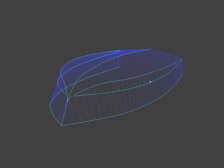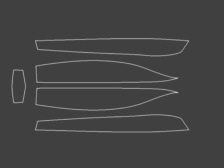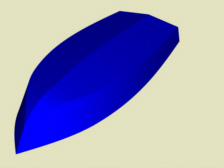.
At the beginning of each boat building project there will appear some questions,
whose answer have a large influence on the later shape of the finished boat.
The first question is for the intended purpose, from which depends a set of
requirements to the characteristics of a boat. Depending upon purpose of the boat
certain demands have priority opposite others. For example in case of designing a
speedboat the speed will be more important than a generous available space.
Usually however the special consideration of a characteristic involves compromises
regarding other characteristics. For example if a hull is designed rather long
and narrowly, its shape caused resistance is reduced and the attainable speed is
increased, at the same time the surface compared with a rather compact hull
increases and the friction resistance increases. If now the speed is the center
of attention, you will tend to a shape with a form resistance as small as
possible, because this increases with the speed in the square. Here already we
see that the optimal boat is a rather relative affair. Now possible building
methods and usable materials result from hull shape and size.
The building method of a boat is in close relationship with the selected or
available material and the possibilities of working on it. The oldest are wood
and animal skins. We can work with wood both in its original form and prepared
to timber materials e.g. plywood. It is suitable particularly for boats, which
weight has to be small, since it is to be regarded due to its structure as a
"micro framework", and framework constructions are characterised by high firmness
in relation to the weight. In most cases hulls can be made of wood without complex
moulds, which favours the production of single's buildings, since wood can be
brought with comparatively simple methods into almost any form, particularly in
connection with resins, like
epoxy .
Small hulls can be realized from wood as almost self-supporting constructions
with only few reinforcements e.g. frames, if they were built with glued plywood
panels or thin wood stripes (veneers) in different directions. Because wood is
porous and therefore water can get into it, a certain expenditure to prevent this
is necessary. The resins and coating systems today available do this if the
application is adequate, so we can make wooden boats, which are not substantially
more sensitive or maintain-more intensive than such from steel or plastic, unless
we select a clear lacquer finish due to aesthetic reasons. Outdoors, the best clear
lacquer can do nothing against the destructive effect of the UV radiation during
a long time, like in case of human skin each sun exposition leaves traces on a
long-term basis, a light protection factor in the coating can retard this, but not
prevent. In this case beauty has simply its price.
Steel as buiding material is important for boats starting from a certain size,
very small vehicles made of steel would have either a quite high weight or a very
thin shell, which would require a filigrane reinforcement similarly as in the
aircraft construction. Since in case of larger vehicles the levers and concomitantly
the tensions in the material become larger, steel with its high tensile strength
fulfills more the requirements. Contrary to wood, steel is available in comparatively
large dimensions, which causes a smaller number of seams e.g. while working with
panels. While the attempt to bring plywood panels into a shape curved in several
directions will cause the damage of the plywood if the curvature is too strong,
you can realize more curved shapes with steel panels, because they can be jolted
and stretched, which causes however a large effort of work.
Alternatively to steel
also aluminum can be used, whereby the lower weight cannot affect itself in every
case fully, due to the lower firmness it must be dimensioned more strongly.
Fiber-reinforced plastics have a far spectrum, concerning the relationship of
firmness and weight, it reaches from mixtures from polyester resins and cut glass
fibers sprayed into moulds to High Tech fibers such as kevlar laminated carefully
by hand. The latters we apply also in the wood epoxy processing.



A criterion for the selection of design and material which can't be neglected is
the effort of material and above all human work. From this point of view the chine
frame design has lots of advantages compared to curved frame design. A chine frame
shell consists first of two soil and side plates and a sternplate. If we
presuppose now the fact that the exterior surfaces of the hull permit a complete
surface development means this that the shell can be joined apart from internal
reinforcements from only five individual plate pieces. If we assume in additon
the fact that the "pattern" is certain before starting the building of the boat and
the plate pieces can be cut by an automat to its final shape, a substantially
reduction of work expenditure results. For this purpose I developed a system of
algorithms, which can produce an accurate mathematical representation of a solid
consisting of several curved and developable surfaces. In practical application
these algorithms run as a LISP script in a commercial CAD application. By the
input of various parameters the characteristics of the designed boat can be
affected such as curvature of the lines, angles of the plates and naturally the
dimensions. The result is a three-dimensional model of the boat as well as its
developed surface. At the same time displacement, weight and their centers were
computed. In the three-dimensional model can be drawn construction details like
keel and frames up to the interior arrangement, which are cut afterwards like the
developed surfaces of the shell by automats based upon the computed file. This
procedure offers the following advantages: 1. Within a short time a row of drafts
can be made and optimized sequentially, time-expensive drawing and calculation
by hand is no more necessary. 2. By procedures such as Rendering and Raytracing
close-to-reality 3-D illustrations of the boat can be produced. 3. By the
connection of CAD (Computer Aided Design) and CAM (Computer Aided Manufacturing)
the production both is more economical and more precise. 4. Since the applied
program produces consistently developable surfaces, which cannot be attained with
conventional methods, it is ensured that the prefabricated parts can
be joined to a boat


 A criterion for the selection of design and material which can't be neglected is
the effort of material and above all human work. From this point of view the chine
frame design has lots of advantages compared to curved frame design. A chine frame
shell consists first of two soil and side plates and a sternplate. If we
presuppose now the fact that the exterior surfaces of the hull permit a complete
surface development means this that the shell can be joined apart from internal
reinforcements from only five individual plate pieces. If we assume in additon
the fact that the "pattern" is certain before starting the building of the boat and
the plate pieces can be cut by an automat to its final shape, a substantially
reduction of work expenditure results. For this purpose I developed a system of
algorithms, which can produce an accurate mathematical representation of a solid
consisting of several curved and developable surfaces. In practical application
these algorithms run as a LISP script in a commercial CAD application. By the
input of various parameters the characteristics of the designed boat can be
affected such as curvature of the lines, angles of the plates and naturally the
dimensions. The result is a three-dimensional model of the boat as well as its
developed surface. At the same time displacement, weight and their centers were
computed. In the three-dimensional model can be drawn construction details like
keel and frames up to the interior arrangement, which are cut afterwards like the
developed surfaces of the shell by automats based upon the computed file. This
procedure offers the following advantages: 1. Within a short time a row of drafts
can be made and optimized sequentially, time-expensive drawing and calculation
by hand is no more necessary. 2. By procedures such as Rendering and Raytracing
close-to-reality 3-D illustrations of the boat can be produced. 3. By the
connection of CAD (Computer Aided Design) and CAM (Computer Aided Manufacturing)
the production both is more economical and more precise. 4. Since the applied
program produces consistently developable surfaces, which cannot be attained with
conventional methods, it is ensured that the prefabricated parts can
be joined to a boat
A criterion for the selection of design and material which can't be neglected is
the effort of material and above all human work. From this point of view the chine
frame design has lots of advantages compared to curved frame design. A chine frame
shell consists first of two soil and side plates and a sternplate. If we
presuppose now the fact that the exterior surfaces of the hull permit a complete
surface development means this that the shell can be joined apart from internal
reinforcements from only five individual plate pieces. If we assume in additon
the fact that the "pattern" is certain before starting the building of the boat and
the plate pieces can be cut by an automat to its final shape, a substantially
reduction of work expenditure results. For this purpose I developed a system of
algorithms, which can produce an accurate mathematical representation of a solid
consisting of several curved and developable surfaces. In practical application
these algorithms run as a LISP script in a commercial CAD application. By the
input of various parameters the characteristics of the designed boat can be
affected such as curvature of the lines, angles of the plates and naturally the
dimensions. The result is a three-dimensional model of the boat as well as its
developed surface. At the same time displacement, weight and their centers were
computed. In the three-dimensional model can be drawn construction details like
keel and frames up to the interior arrangement, which are cut afterwards like the
developed surfaces of the shell by automats based upon the computed file. This
procedure offers the following advantages: 1. Within a short time a row of drafts
can be made and optimized sequentially, time-expensive drawing and calculation
by hand is no more necessary. 2. By procedures such as Rendering and Raytracing
close-to-reality 3-D illustrations of the boat can be produced. 3. By the
connection of CAD (Computer Aided Design) and CAM (Computer Aided Manufacturing)
the production both is more economical and more precise. 4. Since the applied
program produces consistently developable surfaces, which cannot be attained with
conventional methods, it is ensured that the prefabricated parts can
be joined to a boat